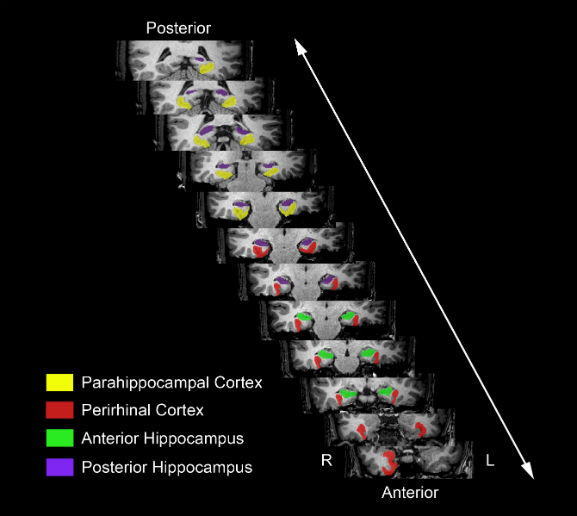Research
Campus Maps
Memory and the Brain
About Dr. Stefan Köhler Lab
 Research in Dr. Stefan Köhler's Memory Lab in Cognitive Neuroscience focuses on the functional and neuroanatomical organization of memory in the human brain. It builds upon diverse methodological approaches: the investigation of memory impairments in neurological patients (e.g., those suffering from epilepsy, Alzheimer’s disease, or Lewy Body dementia), cognitive experiments in healthy individuals, psychophysiological measurements, and the examination of brain activity with functional neuroimaging techniques (fMRI). Questions pursued by our lab include how memory systems interact with the visual system, how memory and affect interact, and whether different parts of the brain support memory for different types of information.
Research in Dr. Stefan Köhler's Memory Lab in Cognitive Neuroscience focuses on the functional and neuroanatomical organization of memory in the human brain. It builds upon diverse methodological approaches: the investigation of memory impairments in neurological patients (e.g., those suffering from epilepsy, Alzheimer’s disease, or Lewy Body dementia), cognitive experiments in healthy individuals, psychophysiological measurements, and the examination of brain activity with functional neuroimaging techniques (fMRI). Questions pursued by our lab include how memory systems interact with the visual system, how memory and affect interact, and whether different parts of the brain support memory for different types of information.
Much of the research conducted in our lab in recent years has addressed the very basic but important ability of individuals to recognize people, objects, and other aspects of the environment as entities that they have encountered before (i.e., recognition memory). Our research program has been informed by the notion that recognition can be based on two different processes, either the recollection of details of a prior encounter with the person/object in question, or a sense of familiarity that is present without any additional information about a specific past related experience. Most people can describe a situation in which they have experienced a compelling sense that another person looks familiar, despite not being able to recall any specific details about where they know that person from. In our research in patients who underwent surgical treatment of epilepsy we have found that these experiences of familiarity can be selectively affected by brain damage, and thus rely on brain structures that are distinct from those that support recollection (Bowles et al., 2007; Bowles et al., 2010). This work has also shown that the brain mechanisms that give rise to feelings of familiarity differ depending on the nature of the ‘thing’ that is being recognized as familiar. For example, our research has revealed that structures in the medial temporal lobe of the left hemisphere are critical for familiarity of words but not faces (Martin et al., 2011).
The Study
 In a study that was published this summer in the Journal of Neuroscience, and that was conducted by a senior graduate student in the lab, Chris Martin, we have also examined the brain mechanisms of familiarity assessment with fMRI in healthy people without any neurological disorder. Here, our interest has been to examine whether different brain structures may come into play when different types of visual objects are recognized as familiar. Cutting-edge multi-voxel pattern analyses of the resulting data allowed us to show that this is indeed the case. Specifically, we found that perirhinal cortex (shown in red) in the right medial temporal lobe carries patterns of familiarity signals for faces whereas parahippocampal cortex, located slightly more posteriorly in the same hemisphere (shown in yellow), carries familiarity signals for buildings. Interestingly, familiarity signals for chairs were found in both structures, suggesting that it is not the class of objects per see that determines where familiarity is computed, but the presence of specific object features. Chairs, like faces, are much smaller than buildings. Unlike faces, they can be used for navigation in a similar way as buildings can.
In a study that was published this summer in the Journal of Neuroscience, and that was conducted by a senior graduate student in the lab, Chris Martin, we have also examined the brain mechanisms of familiarity assessment with fMRI in healthy people without any neurological disorder. Here, our interest has been to examine whether different brain structures may come into play when different types of visual objects are recognized as familiar. Cutting-edge multi-voxel pattern analyses of the resulting data allowed us to show that this is indeed the case. Specifically, we found that perirhinal cortex (shown in red) in the right medial temporal lobe carries patterns of familiarity signals for faces whereas parahippocampal cortex, located slightly more posteriorly in the same hemisphere (shown in yellow), carries familiarity signals for buildings. Interestingly, familiarity signals for chairs were found in both structures, suggesting that it is not the class of objects per see that determines where familiarity is computed, but the presence of specific object features. Chairs, like faces, are much smaller than buildings. Unlike faces, they can be used for navigation in a similar way as buildings can.

Beyond This Study
In other work currently underway, we are taking advantage of psychophysiological techniques (e.g. measurement of heart rate and galvanic skin response) in order to understand whether impressions of familiarity can indeed be characterized as feelings. We are also using this psychophysiological approach to examine whether the affective component of familiarity is disturbed in patients with Alzheimer’s disease or Lewy Body dementia who have difficulties recognizing their spouse and other loved ones.

